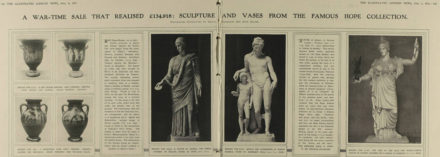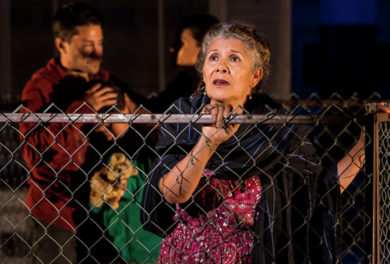
Running Man in his usual spot in the Fran and Ray Stark Sculpture Garden. Running Man, 1978, Dame Elisabeth Frink. Bronze, 75 in. high. The J. Paul Getty Museum, Gift of Fran and Ray Stark, 2005.106.2 © Estate of Elisabeth Frink
It’s been a busy few months getting settled into my new administrative support position in the Decorative Arts and Sculpture Conservation Department of the Getty Museum. What’s amazing about working in this department is being up close to priceless objects brought in for study and care. To see them being meticulously tended to is inspiring. I’ll be walking down the hall corridor and, suddenly, in my path will be a new crate hiding an amazing treasure. My curiosity is piqued and I ask myself, what’s hidden inside? There is always a new surprise.
One day while in the main Museum corridor, one of my favorite paintings, Jan Breughel’s The Entry of the Animals into Noah’s Ark, came by on its way to the Paintings Conservation studio. That same morning I was fortunate enough to see the preparations crew move a tall Rococo clock on loan to the Museum to the gallery for installation on its new earthquake mount.
Perhaps the most dramatic project I’ve yet witnessed in the conservation studio has been the recent conservation work on Dame Elisabeth Frink’s bronze sculpture Running Man. For many years now, Running Man greeted me daily at the lower sculpture garden and nightly, before leaving work, I would always say “Goodnight, Running Man.” I had wondered where he had disappeared to.
On the job I found him again, waiting for some TLC from Julie Wolfe, our sculpture conservator. Running Man was in the decorative arts and sculpture conservation studio for his very first time for a complete conservation treatment.
Julie used a carbon-dioxide cleaning method that removes old protective waxes. This manner of using dry ice for removing wax is a very gentle technique and prevents the conservator and environment from exposure to toxic solvents. Once he was cleaned, an acrylic coating and wax was applied to help protect the surface from weathering.
Here he is in the spray booth for cleaning—strapped down, secure, frozen in his running-in-place pose.

Magdalena Solano, conservation assistant, removes old wax coatings on Elisabeth Frink’s Running Man with dry ice. Artwork © Estate of Elisabeth Frink
Once he was ready to be reinstalled, he was lowered gently by crane into place in the sculpture garden at the base of the Getty hill.

Running Man is carefully lowered into place by head of preparations Kevin Marshall. Artwork © Estate of Elisabeth Frink. Photo: Julie Wolfe
One of my responsibilities is to coordinate all the logistical arrangements required to have outside contractors on site to assist us with cleaning. Several internal departments must be notified of all contractors on site, including Risk Management to insure we have safety certificates on file, and the Security and Reservations for special parking needs. In some cases the Grounds Department assists by letting us borrow the lift they use for tree trimming. In Running Man’s case, our Preparations department secured a 33-ton city crane required to hoist the sculpture back into position in the lower sculpture garden. These are some of the many people working behind the scenes to make sure you have a memorable museum experience.
The next time you visit a museum, think about the people behind the exhibits. Staff study for years to do unique, specialized conservation work, mountmakers who ensure the safety of all of our objects in our earthquake-prone region, preparators who lovingly transport and crate these rare objects, registrars who ensure all the complicated documentation for art movement and receiving loan objects are completed and, finally, the administrative support staff who make sure that conservators and curators have all the proper equipment and supplies they need to carry out their good work.




What a fascinating and well-written article! Brava, Ms. Segler! Some of the Stark sculptures are a bit bizarre, but the Running Man is gorgeous and important. The picture of “him” being lowered back into his spot on the Getty Center grounds is something to see!
I’m a former Gettyite, worked at the Museum from 1982 through 2009. I’m still a big Getty booster! Thanks for a great article.
Thanks Mollie, So glad you enjoyed my article!
I wish I was there to see the Running Man flying.